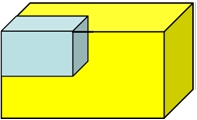|
Definition
(list of HS codes, covered by this card) |
Butter, butter oil and butterfat and other paste-like dairy products such as ghee.
For liquid butter oil see specific cards for ‘Foodstuffs, liquid, low viscosity’ and ‘Foodstuffs, liquid, high viscosity’, dependent on the viscosity and ‘Dairy produce’.
For other dairy products see specific cards for ‘Cheese’ and ‘Dairy produce’.
For products in individual packs see specific card for ‘Retail Sale Packages and final articles’.
|
|
Recommended minimum quantity for each final sample
|
0,5 kg |
| Applicable standards (ISO and EU Norms) and relevant legislation |
- EN ISO 707 Milk and milk products — Guidance on sampling
You should also refer to your national legislation and national guidelines regarding sampling.
|
|
| Suggested sampling tool depending on the method used |
- Pipette-type sampler (L03-01)
- Piston-tube sampler (L05-01)
- Hand drill sampler (Trier or corer) (E02-01)
- Razor wire
- General tools: knife, ladle, etc.
|
| Containers to be used for the sampling |
- Plastic bags, different designs and sizes (P00)
- Plastic bottles, wide mouth opening, size 500-1 000 ml (P03, P04),
preferably not transparent.
- Aluminium foil to protect the sample from light.
The containers must be made of a material suitable for food.
|
| Safety precautions and risk assessment |
- You should be aware of and follow any health and safety instructions in the local risk assessment and/or safe working practices for the location where the sampling is to take place.
- See Health and Safety for the Sampling of Food Products for detailed advice on hygiene and risks for chilled foods.
- The hygiene of food products must be maintained.
- Ensure you have clean and appropriate PPE for the circumstances.
|
|
| Type of consignment |
Procedure |
| Consignment for customs clearance |
The aggregate sample consists of an appropriate number of incremental samples. One sample is usually taken as representing the goods covered by the same customs declaration.
|
| Consignments for CAP (export refunds) |
The final sample consists of an appropriate number of incremental samples or a sufficiently big portion of a bulk block. The sampling strategies depending on packages sizes are described below.
|
| Cartons containing packages <250 g |
Take enough packages from different cartons to form two aggregated samples of 0,5 kg. Do not open packages.
|
Cartons containing packages or cans ≤2 kg
|
Take entire packages from one or more cartons as one sample.
|
| Cartons containing packages or cans >2 kg |
Cut off a cube of 2 kg with a knife from one or more packages as shown and wrap it in cling-film or aluminium foil before putting it in a container.

|
|
| General comments |
- It is always preferable to take complete packages of butter and butterfat as samples. If it is not realistic to take whole packages, use an appropriate tool to cut off whole pieces.
- Drilling cores from butter or butter fat blocks is not a sampling method recommended for customs purposes.
- The critical parameter for the analysis is the moisture content. If it is not possible to take whole unopened packages, you must take every possible precaution to prevent a change in the moisture content by either condensation or evaporation. Samples should be immediately wrapped in cling film or aluminium foil.
- Frozen blocks: If possible take entire packages as samples. When sampling bulk products avoid small pieces (drillings or chippings) as samples. Cut off one sufficiently large piece and take measures to prevent condensation of humidity on the surface of the sample. Do not attempt to form aggregate samples. See Sampling Procedures of Frozen Products in the General Part.
|
| Sampling form |
- Fill in the sampling form. One copy should be attached to the samples and one copy should be kept for the record.
|
| Transport |
- Protect the samples against light and air contact.
- Protect the samples from sources of contamination (odour, liquids, other substances, microbiological growth, etc.).
- Keep cooled or refrigerated during transportation. The temperature of the cooling chain should be recorded.
- Frozen products should preferably be transported in a freezer. Alternatively they can be transported in a refrigerator. Take care that the samples do not thaw during transport. The cooling chain must be maintained and should be recorded.
|
| Storage |
- Protect the samples against light and air contact.
- Protect the samples from sources of contamination (odour, liquids, other substances, microbiological growth, etc.).
- The samples must be stored at a cool temperature, preferably at 0 to 4 °C; see EN ISO 707 for details. The cooling chain must be maintained and preferably be recorded.
- Freeze samples for long-term storage.
- Frozen products must be stored in a freezer. The cooling chain must be maintained and should be recorded.
|

